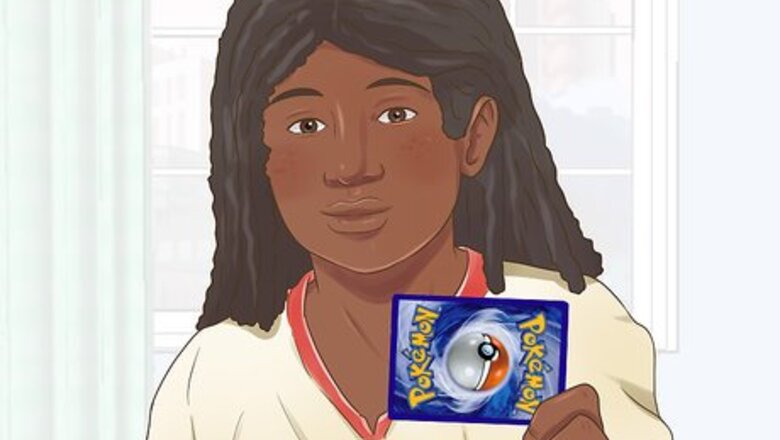
views
Determining the Rarity of Your Cards
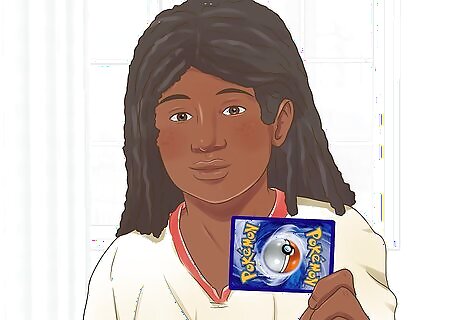
Recall how you acquired your cards. There are many different types of cards in the Pokémon trading card game. These are sold in sets contained in plastic packaging, boxes, promotional packs, tins, and more. Each collection contains a different percentage chance of having a rare card, so knowing how you bought your cards can help locate rare ones. In many cases, more expensive collections of cards, like boxes and tins, have a higher chance of having rare cards. You may want to start looking for rare cards in your boxed or tinned sets.
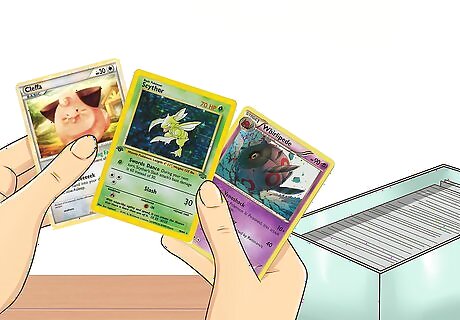
Remove common cards. Cards that are marked in the bottom right corner with a circle (common) or diamond (uncommon) won't likely be worth much. Most of these cards can be safely set off to the side, but over time, even common cards can become rare. When dealing with common cards that are also old, set these aside with other potentially rare cards, as their rarity and value may have increased. You might consider giving old Pokémon cards that aren't worth much as presents to friends or relatives.
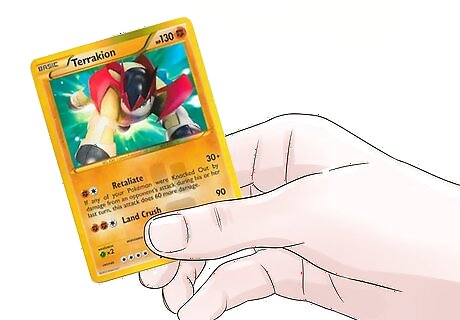
Pick out rare cards. Cards with a star (rare), holofoil picture, a star followed by a letter or symbol (which frequently indicates ultra rare, like ☆H), and secret cards have a better chance of being more valuable. Secret cards are not officially listed as part of the collection. You can find the collection number as a fraction in the bottom right corner of the card. When the number before the slash is larger than the one following it, you have a secret card. Among rare cards, there are sometimes even rarer cards. For example, nearly all holofoil cards are rare, but there's an even rarer variety, the holofoil rare, which is indicated by a star in the lower right corner of the card. Some cards contain small printing errors that make the card especially rare. These are often worth huge sums of money. If you notice an error in your card, it might mean you have one that's particularly valuable.

Discover promotional cards. Promotional cards are given away as part of a special event or are included as a bonus in some packs. These were originally marked with a black star and the words "PROMO." There are also promo cards that have a gold foil star. Older cards will have a promotional symbol beneath the set symbol, which you can find under the right corner of the Pokémon picture. Newer card promo symbols are in the bottom right corner of the card. Some promo cards are given out at events, included with magazine subscriptions, or sent with similar merchandise, like the Pokémon video games. Promo cards can range greatly in value. Some are very common, while others are incredibly rare.
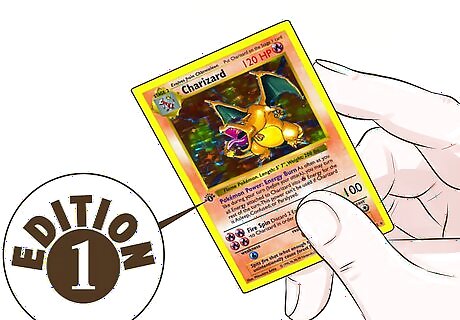
Investigate your cards for first editions. Generally, first edition cards are rarer and worth more money, so these should be given priority when selling. You'll only find first edition cards among older ones made by Wizards of the Coast. Pokémon International does not currently print first edition cards. You can find the symbol indicating the edition of your cards below the lower left corner of the Pokémon picture. The symbol will look like a number enclosed in a black circle with the word "Edition" above in small letters.
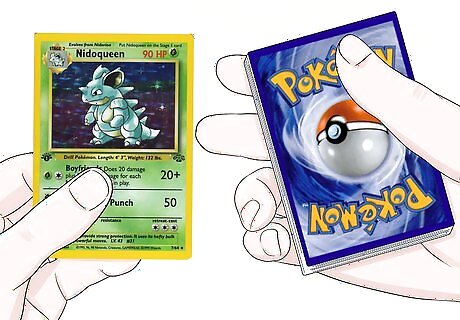
Know your Pokémon card sets. In almost all cases, Pokémon cards will belong to a corresponding set. These sets are usually released four times a year, with each card in a set bearing the same symbol in either the bottom right corner of the card or below the bottom right corner of the Pokémon picture. Complete sets can sell for a lot of money, but older sets might be rare enough to split and sell a card at a time. Some Generation I sets include: Jungle, Fossil, and Team Rocket. Some Generation II sets include: Neo Genesis, Neo Discover, and Legendary Collection. Some Generation III sets include: EX Ruby & Sapphire, EX Dragon, EX FireRed & LeafGreen, and EX Unseen Forces. Some Generation IV sets include: Diamond & Pearl, Majestic Dawn, Legends Awakens, Supreme Victors, Unleashed, and Undaunted. Some Generation V sets include: Black & White, Noble Victories, Plasma Blast, and Dragon Vault. Some Generation VI sets include: XY, Flashfire, Primal Clash, Ancient Origins, BREAKthrough, BREAKpoint, and Fates Collide.

Separate your cards. There are many different ways you might want to organize your Pokemon cards. It might seem tedious, but gathering similar cards together will help you keep track of them better. You might choose to: Divide you cards according to rarity. This way, all the rare cards you discovered in your deck are grouped together and ready to be sold. Collect cards in sets. Since sets often sell for more, this might be a good tactic if you have many full sets of cards. It also might help you to make a list of the rare cards you have. Cards are small and can be lost easily. Having a record can help you recognize when something is missing or misplaced.

Research the cards' worth. This is often the best indication of rarity. However, if you have many cards, it might not be worth your time to research every single card you have. You might want to limit your research to rare or old cards, as these stand a better chance of being valuable. To research the value of your cards, you can: Look up the same card on online sellers or auctions, like Amazon or eBay. The average selling price of your card should help you figure out its base worth. There are also Pokémon card game sites dedicated to tracking the sales of the cards. One favorite site among collectors is Pokémon Prices, which is updated hourly. Check collector catalogs. You should be able to find these online, but you might also be able to find them in your public library. These usually indicate the rarity of the card and its approximate value.
Evaluating & Preserving the Condition of Your Cards

Recognize the different card producers. Originally, Pokémon cards were produced and sold by the company Wizards of the Coast. Now, cards are made and sold by Pokémon International. If you notice differences between old and new cards, it doesn't necessarily mean you have a fake. These cards may only be produced by different companies. By knowing the two producers of Pokémon cards, you could save yourself from accidentally throwing away a salable card.
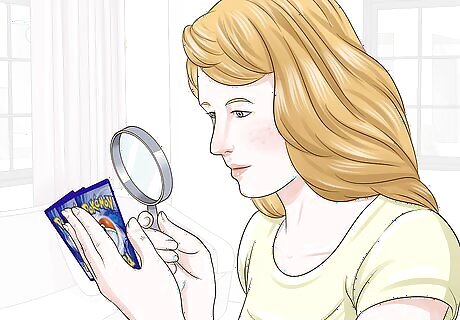
Analyze the condition of each card. Cards that are in new condition or original packaging are almost always worth more money than cards with bends, tears, creases, or other disfiguring marks. Mint condition cards will have sharp, crisp edges, little wear along the edges, and its original gloss. Many card collectors categorize cards as: GEM-MT, which stands for "Gem Mint." These cards have no staining, blemishes, little to no printing imperfections, sharp corners, and a smooth surface gloss. MINT, which should have very little or no damage. These cards differ from gem mint cards in that they frequently have only one minor flaw. NM-MT means near mint to mint, and indicates a very high quality card. At a glance, these might seem perfect, but upon close inspection have one or more slight flaws. EX, also known as "Excellent" cards, will have more obvious damage. There may be rounding at the corners, light scratches, and very light creases. VG stands for "Very Good." These cards may have visible damage, but so long as the damage does not detract from the card's overall appearance, it's considered a VG card. GOOD cards should still be pleasing to the eye, but will be marred by obvious damage, like rounded corners, staining, scratches, and loss of surface gloss.
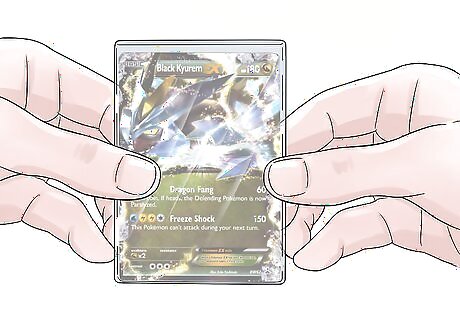
Protect your cards from damage. It might take a while before you're able to sell your card. In the meantime, damage to it can decrease its worth. You may want to use a plastic sleeve or card protector to prevent your rare cards from losing value. Card protectors or sleeves are a must when selling your cards in person. When selling a card face to face, the buyer will likely want to inspect the card before purchasing. A protector or sleeve will prevent accidental damage. In most cases, a card protector 2.5 by 3.5 in. (64 by 89 mm) will fit your Pokémon cards. Some "jumbo" size promotional cards may require larger card protectors.
Finding the Right Place to Sell

Inquire with people you know. If you're too young to sell the cards online, you may find some willing buyers among your friends or fellow Pokémon card game players. You never know when the friend of a friend might be looking for the card you are trying to sell. Many libraries, hobby shops, and schools hold weekly or monthly tabletop gaming events. This might be the perfect place for you to find someone interested in buying your rare cards.
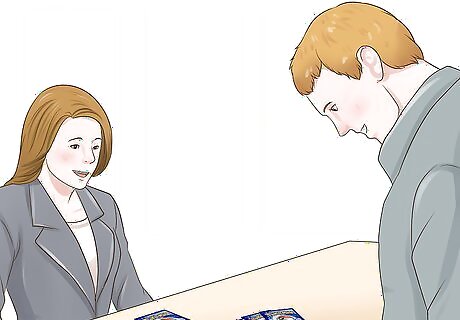
Sell your cards at a local hobby shop. Hobby shops are more than just a place for you to buy games, more Pokémon cards, and play the Pokémon card game with your friends. At most shops, you can also sell your unwanted rare cards to the shop owner. Common cards will be less desirable and sell for less, so it's not likely that a shop owner will want to buy anything less than a rare card. Your local hobby shop might have an announcement board on which you can advertise the card you're trying to sell. If your hobby shop has one of these, ask if you can advertise on it. Be careful when selling your cards at a hobby shop. They'll want to make the biggest profit off their purchase, so they'll try to buy your cards for as little as possible. It may help to prepare yourself to haggle over the sale of the card.
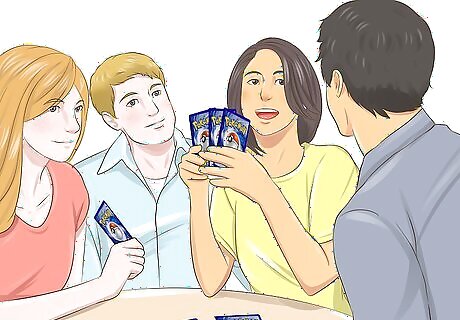
Offload cards at Pokémon events. Even at smaller, local Pokémon card game meet ups, like those held at hobby shops, you might stumble upon someone interested in buying your card. Larger events, like regional and national tournaments, will have even more Pokémon fans who might be interested. You can find a complete listing of official Pokémon card game events on the trading card homepage. In the upper right corner, you should find the "Attend Events" tab, which will provide you with a list of events. Many Pokémon fans can also be found at comic, video game, and cosplay conventions. If an official Pokémon event is impossible to attend, an unofficial, similar convention could be a good place to sell.
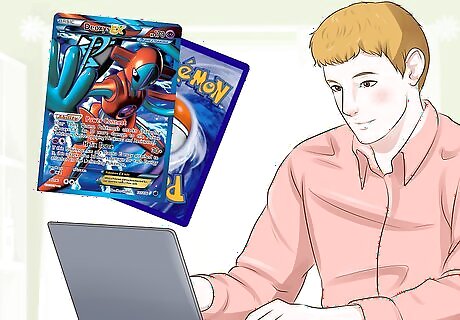
Sell cards online. This is one of the easiest and most visible ways of putting your card up for sale. The more people who see your card, the more likely someone who wants it will see it. However, many online sellers require you to be 18 years of age before you are allowed to use the service. If you're too young to put your cards up for sale online on your own, you can ask for help from a parent or guardian. Common online sellers include eBay, Amazon, and several Pokémon oriented sites, like Professor-oak and the Pokémon Card Market.
Making the Sale
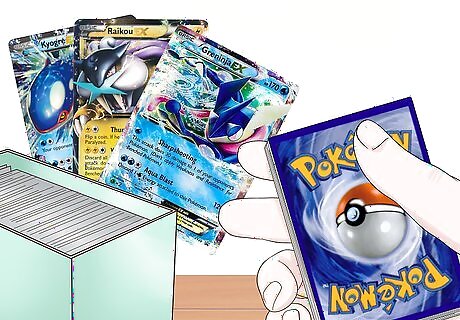
Choose your method of sale. This will depend on your personal situation. If you have a complete set, you may find that you can make the most money by selling it all together. However, in other cases, it may be easiest and/or more profitable to sell your cards one at a time. You could also group together related rare cards and sell them as a bundle. For example, if you have several rare psychic Pokemon, you might sell these together. If you have a large amount of common cards, you may still be able to sell these and make back some cash. You might try assembling common cards into "beginner decks" to sell.

Decide an appropriate selling range. This will be the acceptable range for which you're willing to sell the card. Choosing a price range is very useful when selling, as many buyers will want to haggle the price down. Knowing the bottom range you're willing to sell at will help prevent you from being talked into selling too low. For example, a Lugia EX card can sell for around $26. You might decide that your acceptable selling range for this card is between $23 - $27. A selling range can also help if your card isn't selling. In this case, you might take your card off the market, then put it on the market with a price lower in your selling range. Try to keep your selling range to yourself. If buyers find out your lower limit, they may hard ball you for the lowest possible price, even if they're willing to pay your asking price.
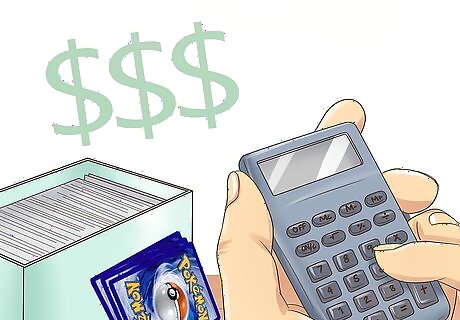
Set an exact price. This will be a specific number in your selling range. In nearly all situations, you'll start negotiating the sale of your card with a specific asking price. This number may increase or decrease during negotiation, but it should never drop below the lower limit of your selling range. If you find that your cards aren't selling, you may have a selling range that's too high for the current market. To improve your chances at a sale, you may want to adjust your range. The market for cards can change drastically in a very short time. If cards aren't selling, or if you only get low offers, you might only have to wait until the market picks back up.

Put your cards up for sale. The fashion you do this will be influence by the place you've chosen to sell your cards. If you're selling cards in person at events, card protectors will keep your cards safe while traveling and handling. Online sales, in most cases, will need a picture to be included when the card is put up for sale. If you're posting an advertisement at your local hobby shop, you can write your own short description of the card, its price, and your contact information. Print this with a picture of the card and post it. If you don't have a camera to take a picture of your card, you could use your cell phone camera, instead.
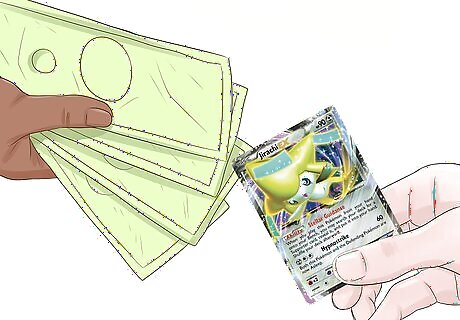
Exchange the Pokémon card(s) for money. You should never give or send the cards you are selling to someone else without receiving payment first. Once the payment has been exchanged, you should give or send your card to the buyer to complete the sale. Now you can use the money for whatever you desire.












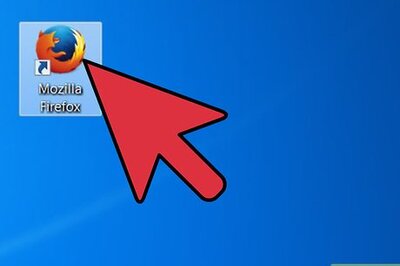






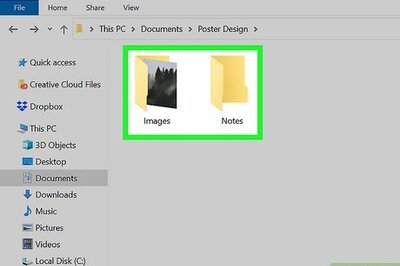
Comments
0 comment